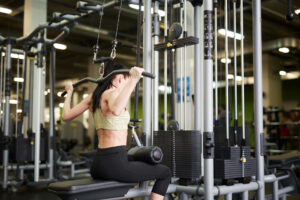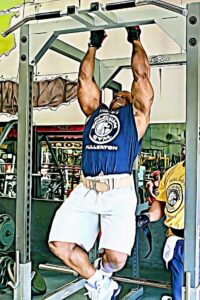
The Strength Sensei on Lat Pulldowns
The pros and cons of these popular exercises
Those who have followed the Strength Sensei over the years know he was never a fan of lat pulldowns. His “go-to” exercises for the upper back didn’t involve any expensive leverage or pulley machines but still provided the most “bang for your buck.” Call him old fashioned, but the upper back exercises Charles R. Poliquin put his muscle-building stamp of approval on were chin-ups and pull-ups.
The primary reason to perform lat pulldowns is to work the latissimus dorsi muscles that flare out when viewed from the back. This relatively long muscle group connects the arms to the lower body and is critical for athletic performance and maintaining optimal posture. When the Strength Sensei was working with pro hockey players or those involved in throwing sports, he prioritized these exercises because the lats create internal rotation of the shoulders.
Although it’s important to strengthen the lats, it’s essential not to overdevelop them. If these muscles are stronger than those that externally rotate the shoulders, you often develop round shoulders. Round shoulders increase the risk of shoulder injuries and even shoulder dislocations.
Before going further, consider that in the early days of the Iron Game, barbell pullovers were one of the most popular exercises for the lats. These were performed with a straight bar, but often many trainees preferred an EZ bar as it provided less strain on the wrists. A dumbbell can certainly be used, grasping the inside edge of one side of the plates, but getting into position to perform this variation can be awkward, forcing you to use less weight.
 Chin-ups and pull-ups were Charles R. Poliquin’s favorite upper back exercises. (Miloš Šarčev photo)
Chin-ups and pull-ups were Charles R. Poliquin’s favorite upper back exercises. (Miloš Šarčev photo)
The pullover was a favorite exercise of Nautilus founder Arthur Jones, referring to the exercise as “The Upper Body Squat.” His obsession with the exercise encouraged him to develop his famous pullover machine. Besides being easy to get into position to perform the exercise, his machine didn’t involve the biceps or grip because the resistance was applied to your elbows.
Although Jones said his machine was the best exercise for the lats, he believed you could work the muscles harder by supersetting his pullover exercise with a lat pulldown. Thus, you would pre-exhaust the lats with an isolation exercise, then incorporate other muscles (primarily the biceps) to work the muscles harder. Jones liked this combination so much that he designed a pullover machine with a lat pulldown attachment because he believed the second exercise in a pre-exhaustion superset needed to be performed quickly (like, within 10 seconds).
Although Jones’ pullover combo certainly could provide a good lat pump, the Strength Sensei believed that the best exercise for the lats was the one you weren’t using. He meant that the body adapts quickly to any single exercise, often in as little as 1-2 weeks. To avoid training plateaus, he believed the type of exercise performed for a single muscle group should be changed frequently…with one exception.
The behind-the-neck lat pulldown is an exercise that may cause shoulder or neck pain, or shoulder instability, particularly in those with rounded shoulders. One peer-reviewed study encouraged many strength coaches and personal trainers to eliminate this exercise from their training toolbox. That study involved 20 athletes with shoulder injuries, and the researchers said all the subjects reported “posterior shoulder pain when the shoulder was placed in forced abduction and external rotation.” (Gross, ML Brenner, SL; Esformes, I; Sonzogni, JJ. Anterior shoulder instability in weight lifters. American Journal of Sports Medicine. 1993 Jul-Aug; 2/4:599-603.)
If you focus on lat pulldowns, don’t expect your ability to perform chin-ups or pull-ups to improve. With these bodyweight exercises, you must pull your body around the chin-up bar, which requires strong core muscles. Pulldowns do little to improve strength in these muscles, along with chin-up machines.
What type of lat pulldown is performed affects the training stimulus. Using a pronated grip (palms facing away from the body) increases the work of the lats. Using a supinated grip (palms facing your body) augments the work of the biceps. Also, for many individuals, a pronated grip places less stress on the wrists. (To learn more about the effects of various grip positions with these exercises, refer to this paper: Sperandei, S.; Barros, M.; Silveira-Júnior, P.; and Oliveira, C., 2009. Electromyographic Analysis of Three Different Types of Lat Pull-Down. Journal of Strength and Conditioning Research, 23(7), 2033-2038.)
Although Charles R. Poliquin preferred chin-ups and pull-ups, he has said, “There’s optimal training, and then there’s reality.” Significantly overweight individuals, particularly women, will have difficulty performing chin-ups and pull-ups. For them, lat pulldowns are one alternative (at least, until they get their bodyweight down). Further, many champion bodybuilders have achieved tremendous lat development without performing chin-ups or pull-ups.
Lat pulldowns are not going away and unquestionably will increase muscle mass and strength in the upper body. They may not be the Strength Sensei’s favorite exercises, but lat pulldowns may be just the thing to get your back “back in shape!” (TSS)
